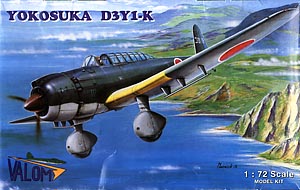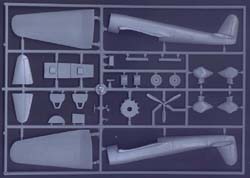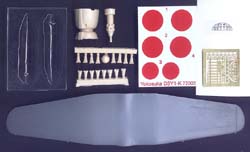Valom 1/72 Yokosuka D3Y1-K |  | History The Yokosuka D3Y1 was a training aircraft based roughly on the D3A Val. In war-torn Japan, limited resources forced factories to try new ideas, and Yokosuka took on the challenge of simplifying and converting the D3A into a mainly wood-based aircraft. The first two aircraft were delivered in July and August of 1944 and featured a rectangular wing instead of the elliptical one found on the D3A. A lengthened fuselage helped balance the airframe, but these initial prototypes revealed a very heavy total weight and the design underwent massive change to try and reduce overall weight. By the time this was completed, the war was nearly over, and only three production D3Y1-Ks were produced. The Kit  Well, finally we can say that we have an injection-molded kit of the D3Y1-K, and it's about time, right? Okay, I know that this is probably a plane that never entered your mind in terms of building, but considering its heritage it could make for an interesting end to a collection of Vals. The kit is a combination of plastic, resin and brass, with a small decal sheet rounding out the contents. The plastic parts feature recessed panel lines throughout that are nicely done. The resin is well cast, and the brass adds that little bit of detail that results in a decent model. Well, finally we can say that we have an injection-molded kit of the D3Y1-K, and it's about time, right? Okay, I know that this is probably a plane that never entered your mind in terms of building, but considering its heritage it could make for an interesting end to a collection of Vals. The kit is a combination of plastic, resin and brass, with a small decal sheet rounding out the contents. The plastic parts feature recessed panel lines throughout that are nicely done. The resin is well cast, and the brass adds that little bit of detail that results in a decent model.
The engine is one of those multi-piece jobs, with separate cylinders fitting onto a one-piece shaft. I suppose this will make for easier painting, and photoetch provides all the rocker arms, a detail that really helps this engine look right. The cowling is also resin and is beautifully done. The interior is made up of a floor, a couple bulkheads, separate seats and control sticks, and photoetch seatbelts & rudder pedals. The instrument panel is also photoetch, complete with film instruments.  Once that construction is out of the way, the rest is pretty basic. The wings feature a one-piece lower wing with the proper dihedral molded in. The landing gear is spatted and comes in three pieces. Other underwing details include dive brakes and an oil cooler fairing. The stabilizers are solid right and left halves, and the other small details include the pitot tube and a nice resin spinner. A vacuformed canopy covers the cockpit. Once that construction is out of the way, the rest is pretty basic. The wings feature a one-piece lower wing with the proper dihedral molded in. The landing gear is spatted and comes in three pieces. Other underwing details include dive brakes and an oil cooler fairing. The stabilizers are solid right and left halves, and the other small details include the pitot tube and a nice resin spinner. A vacuformed canopy covers the cockpit.
The decals are pretty simple, as there wasn't much in the way of markings on the D3Y1. You get six roundels and white codes for the tail. Camouflage is dark green over gray, with yellow leading edges to the wings. The decals are nicely printed with excellent register. Conclusion While this may not be the next ‘"gotta-have" model, it does offer an interesting look at the end of a line of Japanese aviation. The Val had lots of success for the Japanese during the Second World War, and this progression to a wooden replacement is an interesting end to that story.
| 








|
